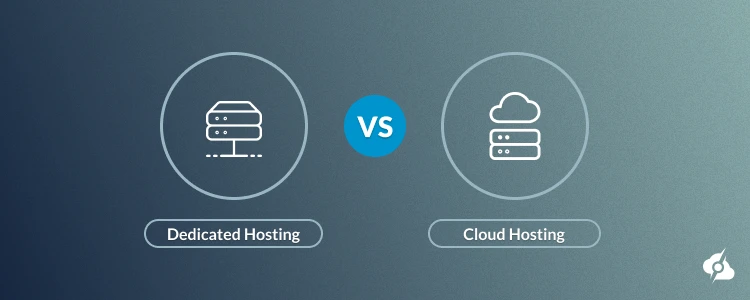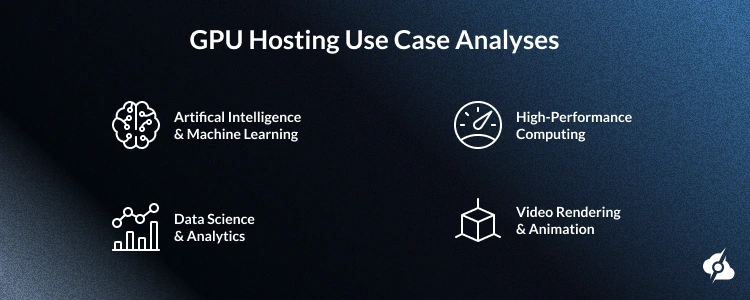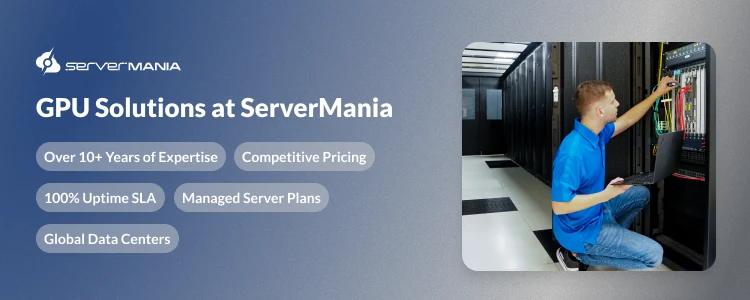Cloud vs Dedicated GPU Servers for Machine Learning: TCO & Performance Comparison

When it comes to machine learning tasks and other AI deep learning projects, investing some time and effort into analyzing and choosing the correct GPU infrastructure is more than important. The rightful GPU infrastructure depends on the nature of your loads, whether it’s image processing, data analysis, AI training, or graphics-intensive tasks that require computing power beyond the traditional system.
And here comes the big question: Cloud GPU or Dedicated GPU Server?
Here at ServerMania, we understand how attractive cloud infrastructure seems due to the fast deployment and low price. On the other hand, we know that many teams require stability over simplicity and prefer dedicated GPU servers instead.
But which is actually better for machine learning?
The answer depends on the specific AI workload you’re dealing with. This involves the project size, requirements, and specific needs such as flexibility and computing power.
To understand which solution (cloud or dedicated) best suits your requirements, we need to go through and understand the trade-offs between these hosting models. In this guide, we’ll walk you through everything you need to know, from a complete performance comparison to TCO breakdown and more.
Cloud vs Dedicated GPU Hosting: Quick Decision Framework
As a leading cloud and dedicated provider, we often analyze potential trends and customers’ behavior to grasp and share with you some real data. Over the past few years, as AI and ML workloads started to rise in popularity, after evaluating more than 150+ AI companies, we have found a very interesting pattern, underlining how important this is.
Choosing incorrectly between cloud GPU servers and dedicated GPU servers can impact your ML budget by 40%, sometimes up to 60%.
In most cases, to stop their loss, customers migrate from dedicated to the cloud or vice versa, which brings a handful of unwanted additional costs. So, to prevent such an outcome for you, we need to take a look at a decision framework, backed by some real-world TCO analysis and performance benchmarks.
Here are the main indicators you should consider upfront:
| Choose Cloud GPU If… | Choose Dedicated GPU If… |
|---|---|
| Workload < 40 hours/month | Workload > 160 hours/month |
| Experimenting with multiple GPU types | Standardized on specific GPU models |
| Unpredictable usage spikes | Consistent, predictable usage |
| Startup or early-stage validation | Production workloads at scale |
| Global distribution needed | Single region deployment |
| No in-house GPU expertise | DevOps team available |
Which, When, and Why?

Cloud GPU servers have proven to be the best for flexibility, quick deployment, and access to several different GPU instances with low upfront investment. They are just perfect for experimenting with AI models, short-term AI training sessions, and workloads with unpredictable traffic.
In short, if you’re just starting and you have no idea how things will spiral out, choosing an AI server to begin with is never a bad decision.
Dedicated GPU servers, on the other hand, are pre-built configurations with an exact target in mind that provide low-latency, top-tier GPU acceleration via NVIDIA CUDA and can support the highest demand for computing power. These GPU servers are “production-ready” for already established workflows, high-traffic loads, ready to fulfill the requirements of any small business or enterprise.
Therefore, if you’re dealing with workloads that fall under the high-performance computing (HPC), such as scientific simulations and complex calculations, dedicated servers would be the way to go.
GPU Hosting Models: Cloud, Dedicated, & Colocation Options
To help you acquire a better understanding of the GPU infrastructure models, we need to evaluate all the options available and find the right balance between cost and performance. Each model comes with its own advantages and downsides, and whether they apply or not depends on the specific workloads.
Cloud GPU Hosting
The cloud-based GPU servers provide flexible access to GPU instances on a shared physical infrastructure, and some of the key characteristics include:
- Pay-per-hour or pay-per-minute billing
- Instant provisioning (~30–60 seconds)
- Fully managed networking and storage
- API-driven architecture for AI workloads
- No upfront capital cost or low investment
As we’ve already mentioned, this model fits quite well with experimental environments for developers and researchers, where you’ll need to test multiple GPU types, or you’ll run short-term AI projects.
Dedicated GPU Servers
In contrast to the cloud infrastructure, dedicated GPU servers provide you with complete control over the hardware, network, and management. Some factors include:
- Fixed monthly server rental price
- Full hardware control (root access)
- No server virtualization overhead
- Highest performance consistency
- Custom network configurations
The dedicated servers are ideal for production workloads and high-performance computing (HPC), where consistently minimal latency and GPU acceleration are a must.
Colocation GPU Hosting
Colocation is the middle ground, allowing organizations to deploy their own GPU hardware in one of the ServerMania data centers for management. Some of the benefits include:
- A complete server hardware ownership
- Custom networking and security options
- Access to the data center infrastructure
- Flexible scaling based on the AI workloads
Colocation is ideal for teams with specific hardware requirements, long-term AI projects, or those looking to combine dedicated GPU performance with data center reliability.
Here is an easy-to-scan GPU hosting model comparison table:
| Cloud GPU | Dedicated GPU | Colocation GPU | |
|---|---|---|---|
| Provisioning Time | 30–60 seconds | 4–48 hours | Varies |
| Billing Model | Per-hour | Monthly | Mixed |
| Performance Consistency | ~92–95% | ~99–100% | ~95–100% |
| Hardware Control | Limited | Full | Custom |
| Scaling Speed | Instant | 1–2 days | Fast |
| Minimum Commitment | 1 hour | 1 month | Flexible |
GPU Hosting TCO: Cost Comparison for Machine Learning
When estimating your GPU infrastructure, whether it’s cloud, dedicated, or colocation, you need to take into consideration the total cost of ownership (TCO). This is often a deciding factor, and beyond hourly rates, you also need to evaluate data transfer, storage, management, setup, deployment, and more…
Cloud GPU Hosting Overview
If you decide to go with public cloud GPU hosting, you will be billed hourly, daily, or monthly, which is what makes this type of infrastructure attractive for short-term projects.
Here’s what the TCO includes:
- Compute Costs (GPU hours): This is the bold cost that covers the time your GPU instances are running, billed per hour or minute, and scales with the intensity or duration of your AI workloads.
- Data Transfer & Egress Fees: Moving large datasets in and out of the cloud can incur additional charges, especially for workload deployments that require frequent data movement.
- Management and Monitoring: While cloud GPU hosting excludes hardware, teams still spend time on configuration, monitoring, scaling, and integrating API-driven workflows.
✅ ServerMania Example:
Here’s a real-world example with ServerMania cloud servers:
- Compute: Starting at $27.79/mo, built for compute-heavy applications and scientific modeling, perfect for short-term AI training or GPU acceleration tasks.
- Flex: Starting at $43.79/mo, ideal for adaptable workloads that require scalability and dynamic GPU instance allocation, making it easy to adjust resources based on project demand.
- Memory: Starting at $65.41/mo, designed for databases, real-time analytics, and caching, providing sufficient RAM and storage for data-intensive AI models.
- Storage: Starting at $71.75/mo, built for secure backups, media hosting, and long-term data storage, ensuring data security and reliable access for ongoing machine learning workflows.
⚠️ Note: The prices shown above reflect the actual ServerMania pricing at the moment of writing and are subject to change in the future to align with market conditions.
Dedicated GPU Hosting Overview
Dedicated GPU servers provide predictable monthly pricing with full hardware control and consistent performance. They remove the virtualization overhead, giving teams powerful GPUs and acceleration for AI training, inference, and data analysis.
✅ ServerMania Example:
Here’s a real-world example with ServerMania dedicated GPU servers:
- Dual Intel Xeon Silver, NVIDIA L4, 256 GB RAM, 1 TB NVMe M.2 – $1,029/month
- Dual AMD EPYC 7642, NVIDIA L4, 512 GB RAM, 1 TB NVMe M.2 – $899/month
- Dual AMD EPYC 9634, NVIDIA L4, 512 GB RAM, 960 GB NVMe U.2 – $1,299/month
- Annual Cost (Most Popular 96C/192T): $899 × 12 = $10,788
- Setup Fee: $0 (included in monthly price)
- Total First Year: $10,788
⚠️ Note: The prices shown above reflect the actual ServerMania server prices with NVIDIA GPUs at the moment of writing and are subject to change in the future to align with market conditions.
Now let’s take a quick look at some workflow scenarios and understand when dedicated makes more sense than cloud, solely from a pricing point of view, based on usage.
| Usage: | Cloud Cost | Dedicated Cost | Winner | Savings |
|---|---|---|---|---|
| 40 hours | $100 | $999 | Cloud | $899 |
| 80 hours | $200 | $999 | Cloud | $799 |
| 160 hours | $400 | $999 | Cloud | $599 |
| 320 hours | $800 | $999 | Cloud | $199 |
| 400 hours | $1,000 | $999 | ~Even | -$1 |
| 500 hours | $1,250 | $999 | Dedicated | $251 |
| 730 hours (24/7) | $1,825 | $999 | Dedicated | $826 |
See Also: Introducing Nvidia L4 & A2 Tensor Core GPU Servers
Cloud Vs. Dedicated GPUs: Performance Comparison
When choosing a GPU cloud-built infrastructure for machine learning workloads, it’s vital to understand the differences between cloud and dedicated servers when looking from a performance point of view.
Training Performance Benchmarks
Training deep learning models, such as ResNet-50, on ImageNet requires substantial computational resources. Many benchmarks indicate the following:
| Images/sec | Epoch Time | Performance Consistency | |
|---|---|---|---|
| Cloud GPU (AWS P4d) | 1,850 | 51 min | ±8% |
| Cloud GPU (Azure NC A100) | 1,920 | 49 min | ±6% |
| Dedicated NVIDIA L4 (ServerMania) | 2,040 | 46 min | ±2% |
These results demonstrate that while cloud GPUs offer flexibility, dedicated NVIDIA L4 GPUs provide higher throughput and more stable performance, making them suitable for large-scale training tasks.
Inference Latency Comparison
When it comes down to inference tasks, especially those that actively involve large language models (LLMs), there is a demand for low latency for real-time applications.
Here’s what the latest benchmarks show:
| Inference Latency | Notes: | |
|---|---|---|
| Cloud GPU | Higher Latency | It can be detrimental for AI inference, potentially slowing responsiveness in applications that require immediate results. |
| Dedicated NVIDIA L4 (ServerMania) | Lower Latency | Enhances the responsiveness for inference tasks, making it ideal for applications where speed and minimal delay are critical. |
Multi-GPU Scaling Efficiency
Scaling across several instance types or multiple GPUs can affect training efficiency. The chart below illustrates how each solution handles scaling:
| Scaling Efficiency | Notes: | |
|---|---|---|
| Cloud GPU | Moderate | Adding multiple GPUs can introduce overhead, leading to diminishing returns as workloads grow. |
| Dedicated NVIDIA L4 (ServerMania) | High | Efficiently scales across multiple GPUs with minimal overhead, maximizing throughput for large-scale training and AI projects. |
Network Performance Impact
Stable network performance is essential for moving data quickly between GPUs and storage. The table below compares cloud and dedicated GPU network reliability:
| Network Performance | Notes: | |
|---|---|---|
| Cloud GPU | Variable | Network speed and stability depend on the cloud provider and region, potentially slowing data transfer during training. |
| Dedicated NVIDIA L4 (ServerMania) | Consistent | A stable network ensures smooth data handling, supporting sustained AI workloads without bottlenecks. |
Summary:
Now that we’ve clearly seen the difference, let’s summarize the key performance metrics and then compare throughput, epoch times, consistency, and inference latency.
| Cloud GPU (AWS P4d / Azure NC A100) | Dedicated NVIDIA L4 (ServerMania) | |
|---|---|---|
| Training Throughput | ~1,850–1,920 images/sec | ~2,040 images/sec |
| Epoch Time | ~49–51 minutes | ~46 minutes(similar to NVIDIA H100) |
| Performance Consistency | ±6% to ±8% variance | ±2% variance |
| Inference Latency | Higher | Lower |
| Multi-GPU Scaling | Less efficient | More efficient |
| Network Performance | Variable | Consistent |
The bottom line here, undoubtedly, is that dedicated GPUs provide much more performance, but again, choosing between the dedicated and cloud infrastructure solely depends on your workload intentions.
See Also: How to Set Up and Optimize GPU Servers for AI Integration
Dedicated GPU Vs. Cloud GPU Servers: Use Case Analyses

Another way to help you achieve excellent performance based on your workload type, budget, and project timeline would be to take a look at some specific use cases.
The following use cases illustrate common machine learning workflows and the optimal infrastructure:
1. Development & Experimentation
At the stage of early development, many organizations require a testing environment to try out models, identify potential issues, and evaluate certain hardware. In those cases, cloud GPU servers would be the ideal solution, offering instant deployment, scalability, flexibility, and a lot of room for experimentation.
- Why: Fast provisioning and flexibility for short-term usage.
- Cost: About ~$500 up to ~$1,500 monthly (varies by usage).
- Duration: From 1 to 6 months, depending on the experiment.
2. Production Training Pipelines
When experiments turn into a production, the regular cloud hosting may or may not be the most cost-effective solution when looking for a long-term perspective.
That’s why retiring the cloud infrastructure and adopting dedicated hardware, for example, dedicated NVIDIA L4 GPU servers, will provide users with consistent performance.
- Why: Continuous retraining, stable performance, and cost savings.
- Cost: From $1,299 up to $2,499/month, depending on configuration.
- Duration: Ongoing (24/7 training) or longer periods of HW utilization.
See Also: What is the Best GPU Server for AI and Machine Learning?
3. Large Language Model (LLM)
When it comes to the heaviest LLM fine-tuning demands, sometimes one GPU, even if dedicated, might not be enough to cover the workflow seamlessly. This is where the dedicated GPU clusters ensure high utilization rates and consistent technology performance over long training runs.
- Why: Sustained GPU utilization and high throughput for multi-day training.
- Cost: $1,299–$2,499/month (depending on setup and interconnect speed).
- Duration: 200+ GPU hours per month, typical for the fine-tuning workloads.
See Also: How to Build a GPU Cluster for Deep Learning
Choose Cloud or Dedicated GPU Server: 5-Question Framework
Another way to quickly identify whether a virtualized cloud or dedicated GPU server matches what you intend to do is to ask yourself the 5 determining questions:
1. What’s Your Monthly GPU Usage?
- Less Than 80 Hours → [Cloud]: If your workload involves less than 80 hours of utilization per month, you’ll save money with a cloud server using the pay-as-you-go method.
- About 80–160 Hours → [Cloud]: When you have more than 100 hours of usage, but less than 200, it’s best to calculate the break-even to compare hourly rates with monthly dedicated pricing.
- 400 Hours or More → [Dedicated]: A full-time workloads gain 40–60% cost efficiency with a dedicated server over potential cloud GPU server equivalents.
👉 ServerMania Tip: If your GPU workloads run daily or continuously (e.g., ML retraining or inference APIs), a dedicated NVIDIA L4 instance delivers consistent output and long-term savings.
2. How Predictable is Your Workload?
This is an important question, because if your machine learning business is variable and depends on seasonal traffic or occasional spikes in demand, a cloud service might be much more effective than a pre-determined (fixed) dedicated infrastructure.
You also need to concider the software and/or platform that you’ll be using so you can leverage your infrastructure and launch the best possible (matching) configuration.
3. What is Your Technical Capability?
It’s also crucial to determine the level of knowledge and technical capability your team is equipped with to determine whether you need guided management.
- Limited DevOps Team: Cloud infrastructure or managed dedicated hosting reduces setup times and monitoring overhead with expert guidance.
- Moderate Experience:If you have the technical expertise to set up your own bare metal from scratch, then a dedicated server would be better.
- Expert Technical Team: Unmanaged dedicated servers provide maximum customization, ideal for advanced ML engineers or infrastructure teams.
4. What Are Your Scaling Requirements?
Another question to provide you with a bit more insight into what your best solution would be is about the scaling requirements of your project. The need for instant expansion or global reach influences the ideal infrastructure.
- Can Scale Instantly: For instant or fast scaling, cloud GPU services are unmatched.
- Short Time Notice: The dedicated GPUs can scale efficiently with proper planning.
- Infrequent Scaling: Dedicated provides stable performance and simpler management.
5. What is Your Duration Estimation?
Your project duration directly affects ROI potential.
- Less Than 3 Months: If your project requires 3 or fewer 3 months, then cloud GPU services provide flexibility without commitments.
- Around 3–12 Months: If you’re about to get committed for more than 3 months, up to a year, you need to compare pricing and performance between cloud and dedicated.
- 12 Months or More: If you’re looking into a project that will last more than a year, then dedicated servers deliver a strong ROI after month six.
Compare: AMD vs NVIDIA GPUs
Choose Your GPU Infrastructure with ServerMania

Choosing the right GPU setup depends on where your team is in its machine learning journey. Whether you’re just experimenting, scaling production workloads, or refining performance, each stage calls for a different strategy to balance cost, control, and computing power.
If You’re Starting
Begin with a cloud GPU for 1–3 months to test performance on the NVIDIA L4, track your usage, and identify your break-even point before committing to dedicated infrastructure.
If You’re Scaling
Review your recent cloud spend, estimate potential savings, and consider migrating core workloads to dedicated GPU servers while keeping the cloud for overflow capacity.
If You’re Optimizing
Focus on improving GPU utilization, cluster performance, and monitoring to maximize ROI—then explore managed GPU hosting for long-term efficiency.
The ServerMania GPU Advantage
With more than two decades of experience in high-performance infrastructure, ServerMania delivers reliable GPU server hosting optimized for AI, ML, and data-intensive workloads. Our platforms are powered by enterprise-grade NVIDIA L4 GPUs paired with Intel Xeon or AMD EPYC processors to deliver exceptional compute power and scalability.
Our clients can choose between fully managed or unmanaged environments, backed by a 99.99% uptime SLA and 24/7 expert support. Every solution is built for flexibility, with transparent pricing and access to our global network of top-tier GPU data-centers. This ensures your workloads run securely, efficiently, and without interruption.
Start your journey today!
- Book a free consultation with a GPU server expert
- Contact the ServerMania 24/7 customer support
Was this page helpful?

